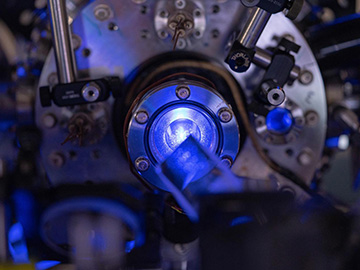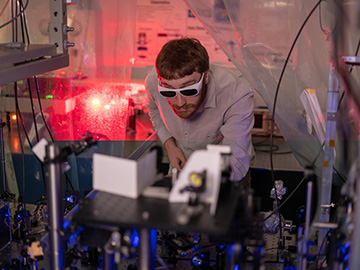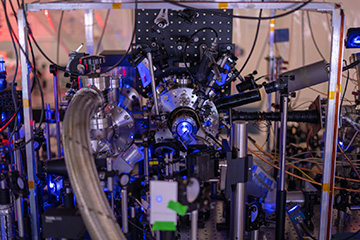
Rice University physicists used laser cooling to create a “strongly coupled,” ultracold neutral plasma, a technique that could find use in astrophysical studies and fusion research. [Image: Brandon Martin/Rice University]
In a tour-de-force of laser manipulation, a team at Rice University, USA, has succeeded in laser cooling a neutral plasma of strontium atoms to a frigid 50 millikelvins—the coldest neutral plasma achieved to date (Science, doi: 10.1126/science.aat3158).
The researchers believe that their creative setup, encompassing ten lasers deployed in three successive cooling and ionization steps, could be extended to even lower temperatures. Those chilly conditions could open up a regime of plasma “strong coupling” heretofore closed to laboratory investigation—and thereby help illuminate the exotic states of matter in giant planets, super-dense stars and the cores of fusion reactors.
The quest for strong coupling
Plasma states—in which the electrons of neutral atoms are stripped away from their host nuclei, and the two exist in an electrically neutral soup of electrons and ions—are usually associated with environments such as the surfaces of stars. At those piping-hot temperatures, the kinetic energies of particle motion tend to swamp the electrostatic, or Coulomb, interactions between the ions.
That means that the ions in such a hot plasma can’t feel each other’s electrostatic influence amid the overwhelming thermal energy. Physicists boil this relationship down to a number called the strong-coupling parameter, Γ, which is essentially the ratio of the electrostatic potential energy to the kinetic energy. In a hot plasma, Γ is much less than one.
Researchers would like to get to “strongly coupled” plasmas, which sport values of Γ considerably greater than one. That’s because the high-density conditions in the cores of stars or confined fusion reactors dramatically increase the relative importance of the Coulomb interaction, making electrostatic energy more important than thermal kinetic energy in the system characteristics. But even if the required high densities can be achieved in the lab, it’s difficult to measure, or even simulate, collision parameters in these highly confined systems.
Cooling things down
There’s another way to get to get to a strongly coupled plasma, however—driving down the plasma temperature to ultracold levels. Such extreme cooling reduces the relative importance of the thermal kinetic energy (the denominator of the strong-coupling parameter), and thereby drives Γ to values greater than one. And, counterintuitive as it seems, such ultracold neutral plasmas have indeed been achieved in the past.
In 1999, Thomas Killian, the lead author in the current study from Rice, pioneered a method of creating an ultracold neutral plasma by starting out cold. Rather than attempting to cool a hot plasma, Killian’s method involved first laser-cooling neutral atoms and then using another laser to ionize them, creating the plasma out of an already cold atom soup.
This method, subsequent work has shown, can push strong coupling to levels as high as Γ = 3. But at that point, the vibrations associated with ion repulsion in the plasma quickly drive up the temperature, a phenomenon known as “disorder-induced heating” (DIH) That heating puts a lid on further strong coupling in the plasma.
An extra nudge

Rice University graduate student Tom Langin in the laser-cooling lab. [Image: Brandon Martin/Rice University]
To get past the DIH-induced limit, Killian, working with Rice grad students Thomas Langin and Grant Gorman, have extended the scheme for creating ultracold neutral plasmas with an extra cooling step. Their method begins a relative “handful” of strontium-99 atoms (half a billion or so), which are laser-cooled with standard techniques to a temperature of 1 mK and gathered in a magnetic trap. Next, the trapping field and cooling laser are turned off.
As the cooled atoms start to heat up and expand, in the space of a mere 6 ms, they’re next zapped with a 10-mJ, 10-ns pulse from 322-nm laser. That laser pulse ionizes around 10 percent of the cooled atoms, creating the plasma. As soon as the plasma forms, counterpropagating beams from other lasers, at 408 nm, re-cool the ions, with beams from additional 1092- and 1033-nm re-pumping lasers also pressed into service to manage several specific excited states and return the ions to the cooling cycle.
White dwarfs and fusion power
Finally, the team used a 422-nm laser to illuminate the center of the plasma, and measured the ion temperature and density using laser-induced fluorescence techniques. The measurements suggested that the plasma temperature had dropped to as low as 50 mK.

[Image: Brandon Martin/Rice University]
At those temperatures, even at the wispy densities of the experiment, the strong-coupling parameter had increased to a whopping Γ = 11 after 135 microseconds. That’s far deeper into the strong-coupling regime than in previous ultracold neutral plasmas. And the researchers believe that even lower temperatures and higher Γ values are possible, through spatial patterning of the lasers, 3-D cooling setups and tweaking the number of atoms.
The team believes that its accomplishment could open up some interesting and rather surprising research avenues. For example, the authors note that a value of Γ = 11 is “comparable to conditions of interest in white dwarf stars,” raising the prospect of illuminating the exotic states in the cores of those superdense bodies. And opening a window on the strong-coupling regime, even in these ultracold plasmas, could also aid the study of plasma instabilities in fusion power research.
“We don't know the practical payoff yet,” Killian said in a press release accompanying the work. “But every time physicists have laser cooled a new kind of thing, it has opened a whole world of possibilities. Nobody predicted that laser cooling atoms and ions would lead to the world’s most accurate clocks or breakthroughs in quantum computing. We do this because it’s a frontier.”
